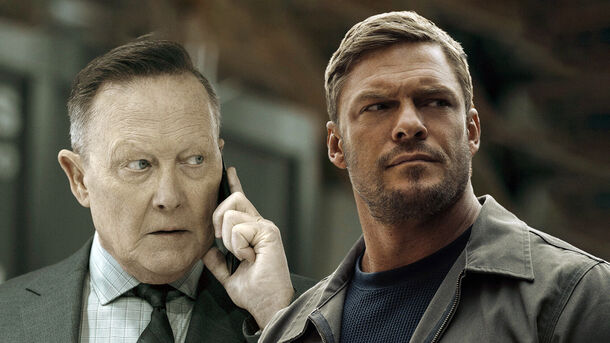Reacher's Season 2 Finale Ruined by Bizarre Departure from the Book

Jack Reacher went from good guy to bloodthirsty terminator.
Summary
- The second season of Reacher turned out to be a great adaptation of Lee Child's Bad Luck and Trouble, but unlike the book, the protagonist's team turned out to be much more bloodthirsty.
- As a result, the final episode featured a murder scene uncharacteristic of Reacher and his friends.
- This change by the writers devalued Reacher's moral decisions and added more mindless action.
Just a few days ago, the second season of Reacher, the Amazon Prime series created by Nick Santora and based on Lee Child's acclaimed Jack Reacher action-thriller book series, concluded. Critics and viewers alike were positively impressed with the sophomore season, which featured even more action than deductions, more anti-establishment than law-abiding, and even more edgy and definitely entertaining plot twists than measured police procedurals.
The writers stayed true to Lee Child's story and adapted the novel, Bad Luck and Trouble, faithfully. However, there are still a number of creative changes, some of which are quite substantial, as they completely change the image of Reacher and his friends. Especially noteworthy is a scene in the last episode that makes the protagonist much more bloodthirsty and less concerned with the ethical justifications. Let's take a look at how critical this plot divergence was and why the finale would have been better without it.
The 110th's Brutal Act in the Finale
As the plot of Season 2 unfolds, several members of the 110th Special Investigations Unit and their new companions who tried to prevent atrocities are killed by conspirators, and so it is no surprise that Reacher and his team are furious and willing to do anything to avenge their friends. But one act was completely unjustified and put the protagonists in the same position as those they fought against.
In the last episode, Reacher found out that the terrorist who wants to buy the missiles, A.M. (Ferdinand Kingsley), doesn't know how to use them and needs a New Age engineer to do it. In the novel, this engineer was only willing to do this because his daughters were being threatened, so Reacher spared the man by pretending to be an engineer himself.
In the show, however, the engineer simply had 'no idea' of the purpose of the missiles — sure, he's in a lesser victim position here, but not that there's a good reason to make him part of the kill count.
Nevertheless, after freeing him and putting him in a helicopter with the pilot who was driving Langston to dump the enemies, Neagley (Maria Sten) fires a missile directly at the helicopter, killing both the engineer and the pilot. By the way, Reacher did kill the pilot in the book, but his death was much more deserved than the engineer's.
This Change Turns the Series into a Cheap Action Movie
This season, Reacher is much more brutal, not hesitating to torture (though the 110th had almost no hostages) and eliminate enemies in the most brutal ways, and therefore the decision of the writers to make the engineer yet another passable plot device for spectacular action seems rather strange and even anticlimactic.
After all, Reacher and his crew aren't just a bunch of killers, but vigilantes who carry out executions in a deliberate manner, depending on whether their opponents deserve it.
Still, even in Bad Luck and Trouble, the protagonist showed far more heroism and dignity in valuing human life. He spared not only the engineer, but also A.M., believing that prison would be a far crueler fate for him. Yes, death really would have been a blessing for the terrorist, but in the book, Reacher did not always take the moral right to decide other people's fate, relying more on the authorities, which made him a more multifaceted character, a living person, not an empty action hero.
Well, hopefully this will be rectified in the next season. We should expect Season 3 at the end of 2024 or later.
